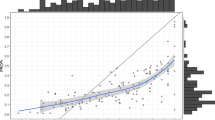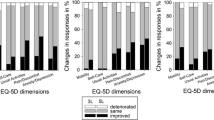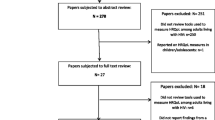Abstract
Objectives
To compare the EQ-5D, 15D, HUI 2, HUI 3, SF-6D, and QWB-SA in terms of their descriptive statistics, score distribution, agreement and responsiveness in a sample of German rehabilitation inpatients.
Methods
Patients with musculoskeletal (N = 106), cardiovascular (N = 88), and psychosomatic (N = 70) disorders completed questionnaires at the beginning (baseline) and end (follow-up) of their inpatient treatment. Comparisons addressed the proportion of missing data, distributional properties, agreement, and responsiveness. Intraclass correlation coefficients (ICC), paired t-tests, and standardized response means (SRM) were computed.
Results
Mean index scores at baseline ranged from 0.48 (HUI 3; psychosomatic) to 0.86 (15D; cardiovascular). At baseline, ceiling effects across all patient groups ranged from zero (SF-6D; cardiovascular and psychosomatic) to 21.6% (EQ-5D; cardiovascular). ICCs ranged from 0.26 (EQ-5D–QWB-SA; cardiovascular) to 0.80 (HUI 2–HUI 3; musculoskeletal). Substantial differences in responsiveness were observed between measures.
Conclusions
Results obtained with different preference-based quality-of-life measures in a sample of patients with mild to moderate disease severity are not equivalent. As differences between measures may have considerable effects in health economic evaluation studies, careful selection of instruments for a given study is essential.



Similar content being viewed by others
References
Drummond, M. F., O’Brien, B., Stoddart, G. L., & Torrance, G. W. (1997). Methods for economic evaluation of health care programmes (2nd ed.). Oxford, UK: Oxford University Press.
Gold, M. R., Siegel, J. E., Russell, L. B., & Weinstein, M. C. (1996). Cost-effectiveness in health and medicine. Oxford, UK: Oxford University Press.
Coons, S. J., Rao, S., Keininger, D. L., & Hays, R. D. (2000). A comparative review of generic quality-of-life instruments. Pharmacoeconomics, 17(1), 13–35.
Kopec, J. A., & Willison, K. D. (2003). A comparative review of four preference-weighted measures of health-related quality of life. Journal of Clinical Epidemiology, 56(4), 317–325.
Brazier, J., Ratcliffe, J., Tsuchiya, A., & Salomon, J. (2007). Measuring and valuing health benefits for economic evaluation (1st ed.). Oxford, UK: Oxford University Press.
Green, C., Brazier, J., & Deverill, M. (2000). Valuing health-related quality of life. A review of health state valuation techniques. Pharmacoeconomics, 17(2), 151–165.
Torrance, G. W., Thomas, W. H., & Sackett, D. L. (1972). A utility maximization model for evaluation of health care programs. Health Services Research, 7(2), 118–133.
Froberg, D. G., & Kane, R. L. (1989). Methodology for measuring health-state preferences—I: Measurement strategies. Journal of Clinical Epidemiology, 42, 345–354.
The EuroQol Group (1990). EuroQol—a new facility for the measurement of health-related quality of life. The EuroQol Group. Health Policy, 16(3), 199–208.
Szende, A., Oppe, M., & Devlin, N. (2007). EQ-5d value sets: Inventory, comparative review and user guide. Kluwer Academic Publishers.
Dolan, P. (1997). Modeling valuations for EuroQol health states. Medical Care, 35(11), 1095–1108.
Sintonen, H. (1994). The 15D-measure of health-related quality of life. I. Reliability, validity and sensitivity of its health state descriptive system. Working paper 41. Melbourne: National Centre for Health Program Evaluation.
Sintonen, H. (1995). The 15D measure of health related quality of life: Feasibility, reliability and validity of its valuation system. Working paper 42. Melbourne: National Centre for Health Program Evaluation.
Sintonen, H. (2001). The 15D instrument of health-related quality of life: properties and applications. Annals of Medicines, 33(5), 328–336.
Brazier, J., Deverill, M., Green, C., Harper, R., & Booth, A. (1999). A review of the use of health status measures in economic evaluation. Health Technology Assessment, 3, 1–164.
Feeny, D. H., Torrance, G., & Furlong, W. J. (1996). Chapter 26: Health Utilities Index. In B. Spilker (Ed.), Quality of life and pharmacoeconomics in clinical trials (2nd ed., pp. 239–251). Philadelphia: Lippincott-Raven Publishers.
Horsman, J., Furlong, W., Feeny, D., & Torrance, G. (2003). The Health Utilities Index (HUI®): Concepts, measurement, properties and applications. Health and Quality of Life Outcomes, 1(54).
Torrance, G. W., Feeny, D. H., Furlong, W. J., Barr, R. D., Zhang, Y., & Wang, Q. (1996). Multi-attribute preference functions for a comprehensive health status classification system: Health Utilities Index Mark 2. Medical Care, 34(7), 702–722.
Feeny, D., Furlong, W., Torrance, G. W., Goldsmith, C. H., Zhu, Z., DePauw, S., Denton, M., & Boyle, M. (2002). Multiattribute and single-attribute utility functions for the health utilities index mark 3 system. Medical Care, 40(2), 113–128.
Brazier, J., Roberts, J., & Deverill, M. (2002). The estimation of a preference-based measure of health from the SF-36. Journal of Health Economics, 21(2), 271–292.
Kaplan, R. M., Sieber, W. J., & Ganiats, T. G. (1997). The Quality of Well-Being Scale: comparison of the interviewer-administered version with a self-administered questionnaire. Psychology & Health, 12, 783–791.
Sieber, W. J., Groessl, E. J., David, K. D., Ganiats, T. G., & Kaplan, R. M. (2007). Quality of Well-Being Self-Administered (QWB-SA) scale. User’s manual; 2004. San Diego: University of California. Retrieved March 5 2007, from http://medicine.ucsd.edu/fpm/hoap/QWB_SA.pdf.
Shrout, P. E., & Fleiss, J. L. (1979). Intraclass correlations: Uses in assessing rater reliability. Psychology Bulletin, 86(2), 420–428.
Deyo, R. A., Diehr, P., & Patrick, D. L. (1991). Reproducibility and responsiveness of health status measures: Statistics and strategies for evaluation. Controlled Clinical Trials, 12(4), 142–158.
Rosner, B. (2005). Fundamentals of biostatistics (6th ed.). Boston: Duxbury Press.
Stavem, K., Froland, S. S., & Hellum, K. B. (2005). Comparison of preference-based utilities of the 15D, EQ-5D and SF-6D in patients with HIV/AIDS. Quality of Life Research, 14, 971–980. .
Conner-Spady, B., & Suarez-Almazor, M. E. (2003). Variation in the estimation of quality-adjusted life-years by different preference-based instruments. Medical Care, 41(7), 791–801.
Longworth, L., Bryan, S. (2003). An empirical comparison of the EQ-5D and the SF-6D in liver transplant patients. Health Economics, 12, 1061–1067.
Hahl, J., Hamalainen, H., Sintonen, H., Simell, T., Arinen, S., & Simell, O. (2002). Health-related quality of life in type 1 diabetes without or with symptoms of long-term complications. Quality of Life Research, 11(5), 427–436.
Feeny, D. H., Wu, L., & Eng, K. (2004). Comparing short form 6D, standard gamble, and Health Utilities Index Mark 2 and Mark 3 utility scores: Results from total hip arthroplasty patients. Quality of Life Research, 13(10), 1659–1670.
Pickard, A. S., Johnson, J. A, & Feeny, D. H. (2005). Responsiveness of generic health-related quality-of-life measures in stroke. Quality of Life Research, 14, 207–219.
Brazier, J., Roberts, J., Tsuchiya, A., & Busschbach, J. (2004). Comparison of the EQ-5D and SF-6D across seven patient groups. Health Economics, 13, 873–884.
Grootendorst, P., Feeny, D., & Furlong, W. (2000). Health Utilities Index Mark 3: Evidence of construct validity for stroke and arthritis in a population health survey. Medical Care, 38(3), 290–299.
Stavem, K. (1999). Reliability, validity and responsiveness of two multiattribute utility measures in patients with chronic obstructive pulmonary disease. Quality of Life Research, 8(1–2), 45–54.
Marra, C. A., Rashidi, A. A., Guh, D., Kopec, J. A., Abrahamowicz, M., Esdaile, J. M., Brazier, J. E., Fortin, P. R., & Anis, A. H. (2005). Are indirect utility measures reliable and responsive in rheumatoid arthritis patients? Quality of Life Research, 14(5), 1333–1344.
Hatoum, H. T., Brazier, J. E., & Akhras, K. S. (2004). Comparison of the HUI 3 with the SF-36 preference based SF-6D in a clinical trial setting. Value Health, 7(5), 602–9.
Acknowledgements
Our thanks go to HUI Inc. and John Horsman for permitting this project and to John Brazier for providing the SF-6D weights and Harri Sintonen for providing the 15D weights. We would also like to thank our cooperation partners Dr Klaus Drüner and Dr Detlev Besch and their colleagues at the rehabilitation clinic Göhren/Germany, and Dr Martin Grunze and Dr Helmhold Seidlein of the rehabilitation clinic Trassenheide/Germany. Further thanks go to Kathrin Bezold for her assistance with data collection. We gratefully acknowledge the constructive comments and suggestions received from John Brazier and the anonymous referees. This project was funded by a grant (no. 01GD0106) from the German Federal Ministry of Education and Research within the North German Network for Rehabilitation Research (NVRF).
Author information
Authors and Affiliations
Corresponding author
Rights and permissions
About this article
Cite this article
Moock, J., Kohlmann, T. Comparing preference-based quality-of-life measures: results from rehabilitation patients with musculoskeletal, cardiovascular, or psychosomatic disorders. Qual Life Res 17, 485–495 (2008). https://doi.org/10.1007/s11136-008-9317-6
Received:
Accepted:
Published:
Issue Date:
DOI: https://doi.org/10.1007/s11136-008-9317-6




